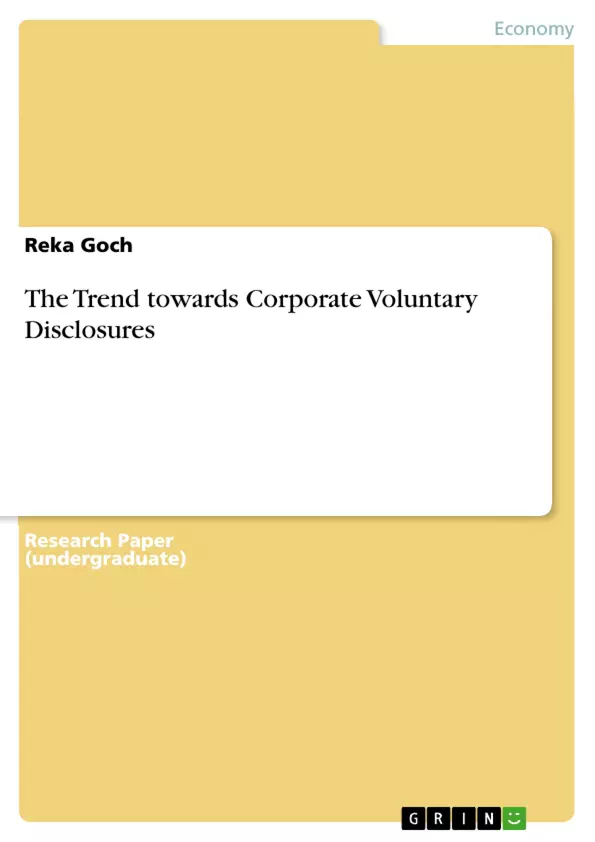Introduction
Recent scandals, like the Enron Bankruptcy, undermined the investors trust in the information given by the corporations. Enron, one of the biggest consolidated group in the US and in the world, became famous all over the world by the surprisingly bankruptcy in December of 2001. Even a few weeks before the petition of bankruptcy analyst recommended to buy Enron stock and thousands of investors lost their savings or their pension backups. By creative balancing Enron succeeded to take advantage of gaps in the Generally Accepted Accounting Principles (GAAP). Financial data in the annual business report was manipulated so that investors who relied on this information made wrong investment decisions. Likewise investors and analyst trusted in the confirmation of the accounting firm Arthur Andersen & Partner which was authorized to prove the correct balancing of Enron.
The Enron Bankruptcy is just one example, many bankruptcies like the ones of Sunbeam, Waste Management or Global Crossing had followed yet. “Creative balancing” gained currency among other listed corporations and the value and the profitability of blue chips were overvalued. Scandals like this emphasize the importance of the given information for the entire stakeholders, critically the investment community, because they have a deep impact on the investment decisions. Corporations are more and more forced to offer corporate voluntary disclosures which fulfill the “call for evidence of activities” (cf. Pricewaterhouse- Coopers, 2000b, p. 1) made by the business environment and to regain public trust. Additionally, the globalization of markets has a strong influence on the corporations’ orientation. More and more corporations become international and listed. Thus, the competition on capital market increases and the constant need for capital requires a better explanation on the business performance. To help investors with their capital allocation decisions, corporations have to provide a more reliable, relevant, and useful information on a voluntary basis. In general, investors should get a better understanding of the corporation by more transparency. So, the traditional reporting in a vast number of corporations, based on financial data, is added by voluntary disclosures with the hope to hasten the process of the stock markets recognition of their corporate value.
...
Inhaltsverzeichnis (Table of Contents)
- Introduction
- Insights into the Corporate Disclosure Process
- Value Reporting: Investors' Need of Information
- Failures of the Current Corporate Reporting
- Valuation Problem
- Communication Problem
- Consequences: Necessity for Improved Disclosure Process
- Benefits and Disadvantages of Improved Disclosure Process
- Tendencies of Corporate Reporting
- Efforts to Improve Corporate Reporting
- Changing Accounting Regulations in Germany
- Trend towards Voluntary Disclosures
- Conclusion
Zielsetzung und Themenschwerpunkte (Objectives and Key Themes)
This paper examines the growing trend of corporate voluntary disclosures, exploring its drivers, benefits, and challenges. The focus is on how these disclosures address the limitations of traditional financial reporting and meet the evolving information needs of investors in a globalized market. The Enron scandal and its aftermath are used to highlight the importance of transparency and trust in corporate reporting.
- The impact of the Enron scandal on investor trust and corporate reporting practices.
- The need for improved corporate disclosures to address valuation and communication problems.
- The benefits and challenges of voluntary disclosures in enhancing transparency and investor confidence.
- The role of changing accounting regulations and globalization in driving the trend towards voluntary disclosures.
- The growing importance of non-financial information and value reporting in investor decision-making.
Zusammenfassung der Kapitel (Chapter Summaries)
- Introduction: The chapter introduces the subject of corporate voluntary disclosures and their growing importance in the wake of scandals like Enron. It emphasizes the need for greater transparency and trust in corporate reporting to address investor concerns and facilitate efficient capital allocation in a globalized market.
- Insights into the Corporate Disclosure Process: This chapter examines the concept of value reporting and the need for information that goes beyond traditional financial data. It delves into the failures of current corporate reporting practices, including valuation and communication problems, and their consequences for investors. The chapter concludes by exploring the benefits and disadvantages of improved disclosure processes, highlighting the importance of striking a balance between transparency and competitive advantage.
- Tendencies of Corporate Reporting: This chapter examines the evolving landscape of corporate reporting practices, focusing on efforts to improve reporting quality, changing accounting regulations in Germany, and the increasing trend towards voluntary disclosures. It analyzes the driving forces behind these changes and their implications for corporations and investors alike.
Schlüsselwörter (Keywords)
Corporate voluntary disclosures, value reporting, investor trust, transparency, corporate governance, financial reporting, accounting regulations, globalization, Enron scandal, stakeholder engagement, non-financial information, capital markets.
- Quote paper
- Reka Goch (Author), 2005, The Trend towards Corporate Voluntary Disclosures, Munich, GRIN Verlag, https://www.grin.com/document/51603



